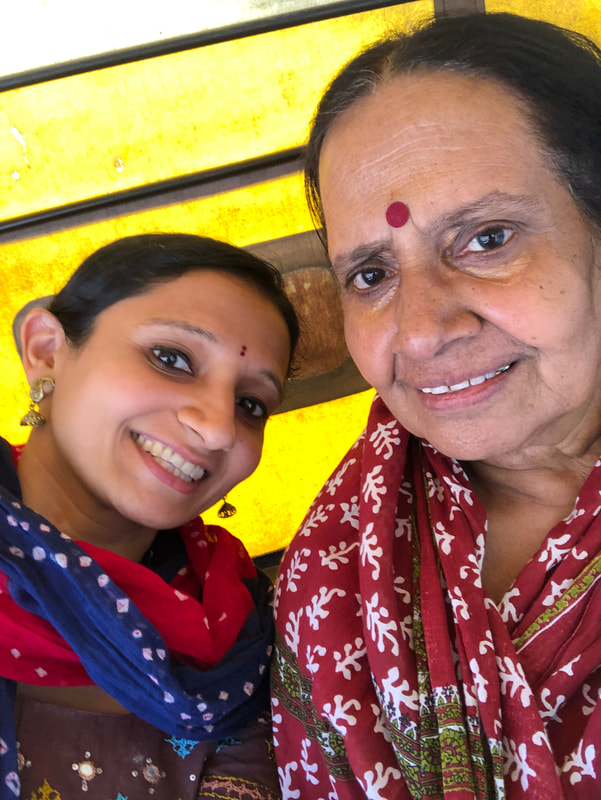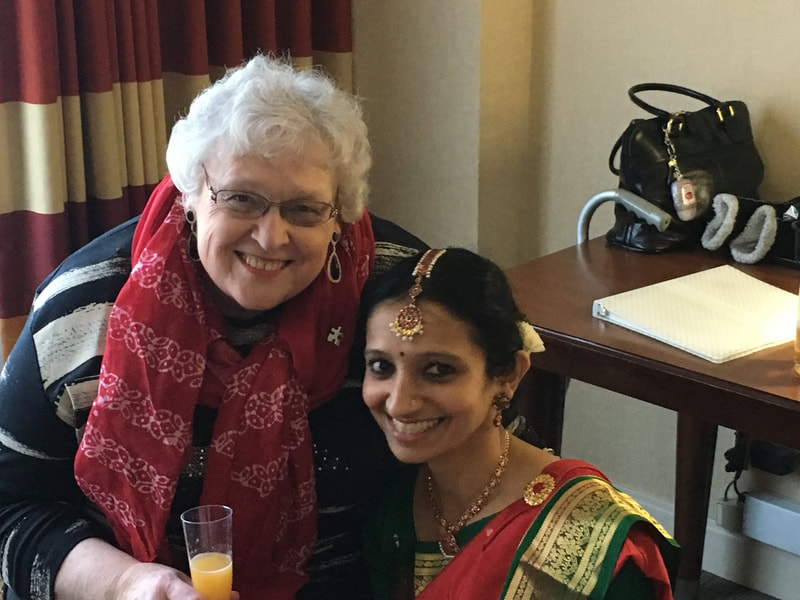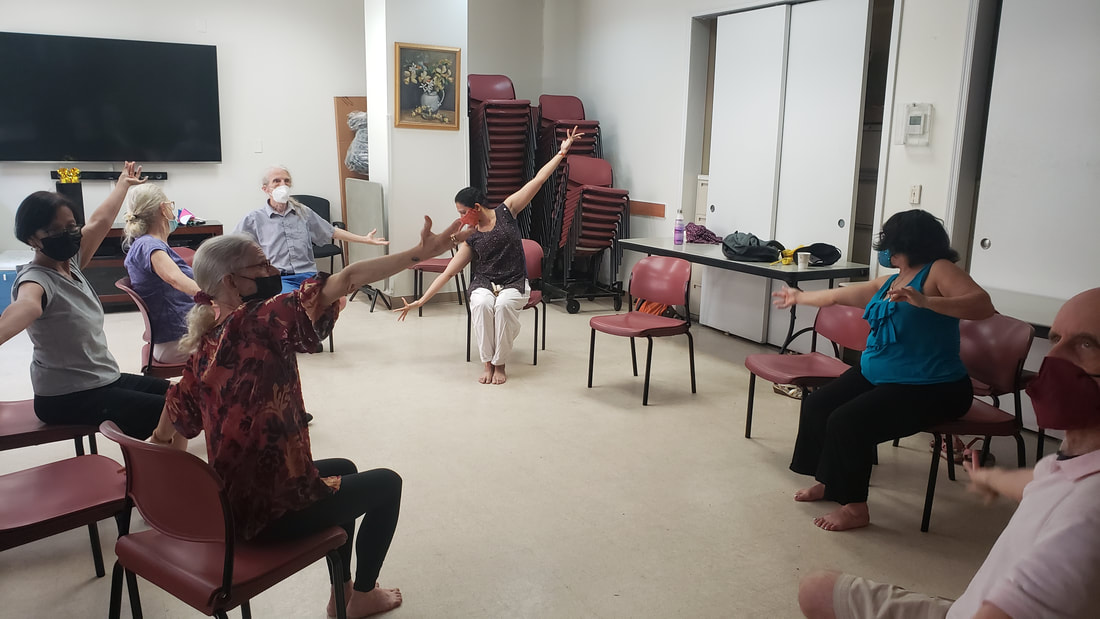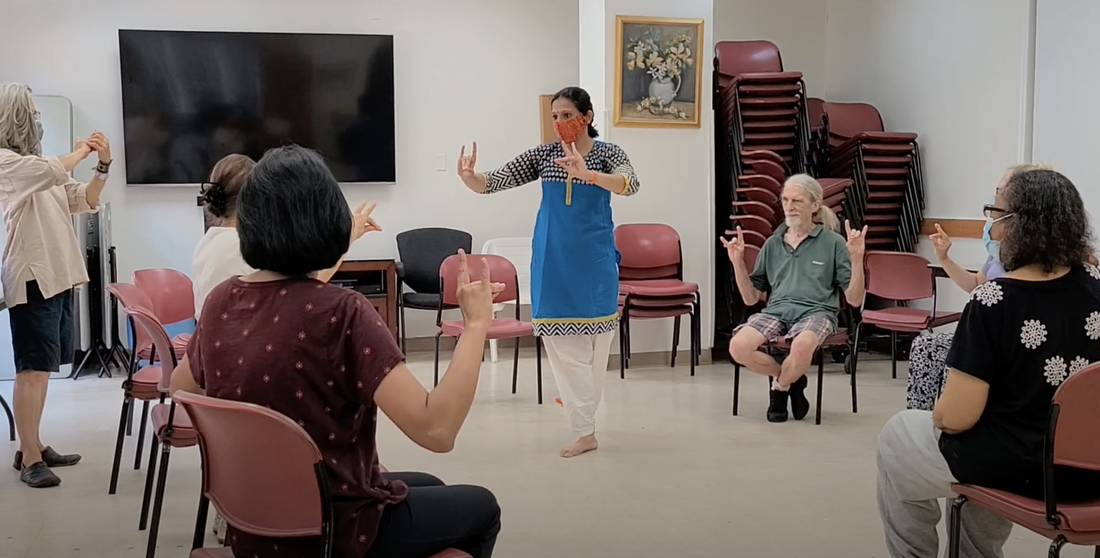|
Bharatanatyam for creative aging: what led me to this path? While the arts have been shown to be helpful for people regardless of age, immersion in artistic endeavors has been found to be especially helpful for older adults. My passion for Bharatanatyam for creative aging comes from women in my life and the experiences they have had. I am a practitioner of Bharatanatyam – a dance form that originated in the temples of South India more than 2,000 years ago, and I have been working on using Bharatanatyam to create spaces for creative aging in New York City. In addition to being a practitioner and performer of Bharatanatyam, I am also a neuroscientist. For my graduate and postdoctoral work, I examined neuronal circuits that lead to the generation and propagation of epileptic seizures. Currently, I collaborate with organizations in India and the U.S in the areas of mental health and substance abuse, aging and palliative care, and neurological disorders. As a dancer, I am also interested in the use of dance as a way of self-expression to promote positive mental health. I find both science and dance to be extraordinarily creative pursuits, and I find many points of convergence between the disciplines. To this end, I curate a production called “Vichaar” (the Sanskrit word means “thought” or “perception”) where I take aspects of Bharatanatyam, such as emotions and movement, and explore their neuroscientific basis. In a sad turn of events a few years ago, I lost my mother and mother-in-law over six months. Losing them in so drastic a manner made me realize the ways seniors are treated in our society. My mother who was a Carnatic vocalist passed away from lung cancer gasping for breath. What was so tragic was that while she was getting excellent medical care, not one person cared to know about her music and her voice which could move people's souls. To ensure that other seniors don't feel unheard and unseen, I have devoted my career so that my science and dance training needs to be geared towards benefitting senior citizens. Performing and practicing in my neighborhood of uptown Manhattan, and my work with organizations such as Center for Adults Living Well @ the Y, Sirovich center for balanced living, DOROT, Su-Casa, and The Creative Center have made it clear to me that Bharatanatyam has an intense power to reach diverse audiences. My role is as a vehicle in making the joy of expression, movement, and music in the form of Bharatanatyam available and accessible to all. In this series of articles, you will find information about my experiences in incorporating Bharatanatyam for contemporary audiences for individuals with and without disabilities. My goal is to curate my learnings as I work with older adults so that dancers, non-dancers, senior citizens, and their caregivers can use this information and apply it in their settings. In the video above, you can see part of a Bharatanatyam piece called the "Ganapati kautvam" to invite Lord Ganesha into the performance and the space. This demonstration was done at The Frederic Fleming House at W22nd Street in NYC for its residents.
1 Comment
My journey as I work towards Bharatanatyam for all 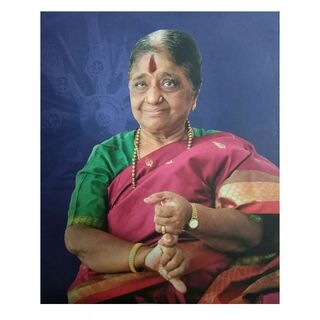 My guru, Smt. Maheshwari Nagarajan (Amma) My guru, Smt. Maheshwari Nagarajan (Amma) Learning in Bharatanatyam is a lifelong process, and I am fortunate enough to still keep learning from my gurus (Maheshwari Amma, Vanitha Didi, and Jayan Sir) who are based in Ahmedabad, India. My journey towards Bharatanatyam for all has been twofold:
Bharatanatyam’s depth is rooted in Indian culture and history and the various cultural and political upheavals that India went through. It may seem counterintuitive to use a 2,000-year-old art form to express current thought, but given that the form and its pedagogy is steeped in nuance and depth, to me, it seems natural! Besides, a dance form that has thrived in spite of disruptive forces such as colonization has in it the power to withstand disorder, and be relevant to diverse populations. My science, science writing, and science education training also come in handy here. The strategy I use to make Bharatanatyam relevant and understandable to all is not so different from writing about science for a lay audience. I have written here how my scientific training makes me a better dancer, and how my dance training makes me a better scientist. The scientific principle of synaptic plasticity (the capacity of the brain to change with experiences), the positive impact of movement for mental health, and the power of self-expression lie at the core of my work. 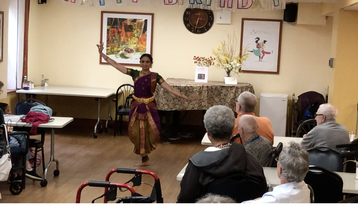 Demonstration at The West Side Federation for Senior and Supportive Housing at W76th street in NYC Demonstration at The West Side Federation for Senior and Supportive Housing at W76th street in NYC Making Bharatanatyam inclusive: the approach One challenge I’ve faced for an audience with no or very little exposure to Bharatanatyam or any Indian art form is its relevance in a Western/current context. Many of the pieces we are taught as part of the traditional repertoire (called “margam”) are related to Indian (Hindu) deities and stories which may be unfamiliar to a modern audience. I have found that there are many solutions to this challenge; what has worked for me is to bring out the universality of Bharatanatyam. There are many, many aspects of Bharatanatyam that are relevant to people all over the world today. As an example, students of Bharatanatyam may be familiar with the movement of stringing flowers to make a necklace for one’s braid, or a garland for an idol. Even though I lived and grew up in India, I never actually put together flowers for this purpose, so the movement was always imaginary to me. However, for Western audiences, I have used similar hand gestures ("mudras") to arrange flowers in a vase. Another motif that could be relevant is that of decoration or adornment. This could be used to use mudras to show setting table for guests, or to garnish a dish to serve friends. Finding ways to connect Bharatanatyam with something happening in the lives of the participants is also uniquely helpful. A few examples that have worked for me are to use specific rhythmic patterns that remind participants in NYC of the cadence of the city’s subway system. The essence of performance comes through when commuters experience a mariachi band or the subway performers. Looking at tourists in NYC absorbed in their maps and selfies while neglecting to take in this marvelous city also evokes the emotion ("rasa") of laughter (hasya). Many times, people may find movement not intuitive and a bit uncomfortable and shy; on these occasions, finding ways for people to engage that are other than movement may be beneficial. The avenues that have worked for me are music and painting. For example, I was able to bring this painting to the session to talk about the emotion of love (sringara). 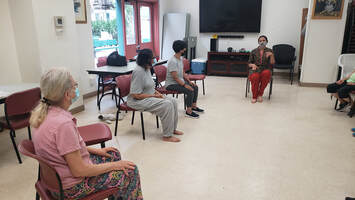 Sloka demonstrating a rhythmic pattern seated with her hands Photo credit: Padma Narayanan Sloka demonstrating a rhythmic pattern seated with her hands Photo credit: Padma Narayanan Making Bharatanatyam inclusive: the specifics In this article you will find specific ways in which I have tried to make Bharatanatyam inclusive. These methods are evolving as I get a chance to work with more organizations and participants, but the scientific principle of synaptic plasticity (the capacity of the brain to change with experiences), the positive impact of movement for mental health, and the power of self-expression lie at the core of this curriculum. Rhythm: Bharatanatyam is based on the Carnatic style of music, which has over hundred patterns of rhythm. As students of Bharatanatyam, we learn the ways in which combination of steps fits with the rhythmic patterns to give rise to aesthetically pleasing movements. While working with people that may not have had exposure to this kind of dance and music, one can think of how certain rhythmic patterns are reminiscent of daily activities. The hum of a fan, the sound of a subway approaching the station, a horse’s gallop etc. are all examples of relating rhythm to participants’ daily lives. Other ways of approaching rhythm are to have participants clap in rhythm, or seated with hands on their laps. Reciting the syllables (the “sollukuttu) is another way people can engage. The beauty of this approach, I feel, is that participants have a variety of ways to engage and that they can be layered on top on one another. So, a participant may want to start by clapping to the rhythm in various speeds, then add reciting the syllables, then adding the feet seated, and finally, clapping, reciting, and responding to the rhythm standing up, and perhaps even moving in space! I have found that these are additional ways to embody rhythm and are quite helpful and most importantly, help build an inclusive approach.  Sloka demonstrating a bat with her hands Sloka demonstrating a bat with her hands Rasas: Bharatanatyam has in it codified the nine emotions of laughter, compassion, anger, courage, fear, disgust, wonder, and peace. For an older adult population specifically, the language of navarasas can be very useful to talk about things relevant in participants' lives. One participant, while talking about the emotion of love (sringara) shared how for her, love was tinged with grief at just having lost her partner. Mudras or hand gestures: Students of Bharatanatyam are taught more than 50 mudras that use either one, or both hands. Many of these mudras (e.g., the crown of a king using tripataka) may not be that relevant to a contemporary audience. But I have found that one way to incorporate such mudras could be to ask participants to show a king as a king vs. a king when a child is acting as though he is a king. Bharatanaytam is a living, evolving language, and hand gestures are a great way to have participants contribute to this language (e.g. the hasta for a bat is one that I created after studying about bats and how they fly).  Sloka showing the trunk of an elephant to seated participants. Photo credit: Padma Narayanan Sloka showing the trunk of an elephant to seated participants. Photo credit: Padma Narayanan Music and chanting: For audiences that may have had some exposure to Indian music, one can use music for warm-up or to cool down at the end. As a student of Carnatic music from Smt. Nivedita of Raga Chitra Fine Arts, I have brought in music set in certain melody (“raga”) to convey a specific mood or feeling. Storytelling: Pieces in Bharatanatyam can be those that explicitly tell a story, or those that convey a mood. I have found storytelling through mudras, rasas, and rhythm to be a very effective way to get people from all backgrounds engaged. Storytelling using the eyes and facial expressions can also be very powerful and creative aids to bring to life to a narrative structure and a story. Visualization: One of my favorite pieces in Bharatanatyam is where the dancer (the storyteller) is visualizing Lord Nataraja – the god of dance. The feeling of the piece is to communicate the feeling of awe the dancer feels at having seen such a divine being. The strategy I use to bring across this feeling is to imagine a dinosaur standing in front of me in the flesh. While there will be feelings of fear and apprehension, I would think that the primary emotions would be of surprise, of wonder, and awe. In a similar way, for an older adult population, I have used the imagery of baby elephants playing with other baby elephants as well as other elephants in the herd. I felt that this was a great choice, as by default, elephants are stable. Additionally, elephants are almost never in a rush, which also helps in the comfort level of participants, as does the inherent playfulness of babies, and baby elephants in particular. Evoking elephants may come in handy if the participants have a fear of falling because their stability evokes and inspires confidence. A short video where I am demonstrating this can be found below. The video is part of the Dance for PD Community Festival: Around the World, Around the Clock, a FREE 24-hour virtual celebration that featured classes, panel discussions, and film screenings to highlight the diversity and breadth of the Dance for PD family. You will see that I am seated, and am demonstrating the trunk of an elephant to seated audiences, giving participants multiple options to participate, and bringing in imagery of baby elephants playing with the other babies and adults in the herd. Movements done seated or standing, with the support of a chair: While there are many aspects of Bharatanatyam that can be done seated, the dance form also has a very rich vocabulary of movements that are done in a specific sequence. Movements (adavus) making up the sequence of movements (jatis) can be done seated in order to make Bharatanatyam more inclusive, I have re-imagined many jatis in a way so that they can be done either seated, or with the support of a chair.  Sloka working with participants at the YM & YWHA of Washington Heights and Inwood on how to work on our gaze. Photo credit: Tom Frambach Sloka working with participants at the YM & YWHA of Washington Heights and Inwood on how to work on our gaze. Photo credit: Tom Frambach The power of the gaze: Students of Bharatanatyam are trained to pay a lot of attention to their eyes, how their eyes appear to the audience, and our goal is always to make our gaze expansive, not limiting. I have found that working on specific eye movements can be of tremendous benefit to seniors, as it gives them an opportunity to practice their eye coordination.  Sloka working with participants at the YM & YWHA of Washington Heights and Inwood on the famous slokam Mooshika Vahana. Photo credit: Tom Frambach Sloka working with participants at the YM & YWHA of Washington Heights and Inwood on the famous slokam Mooshika Vahana. Photo credit: Tom Frambach Using repetition to engage participants' creativity: Students of Bharatanatyam and Carnatic music know the power of repetition, and why we repeat a certain verse a number of times. As a child, I failed to understand its purpose, but over time, I've realized we repeat lines or stanzas for emphasis, to highlight a verse's derived meaning, to provide depth to a rasa, and to tell the story through another character. With my participants at Center for Adults Living Well @ the Y and DOROT, I have been working on the famous sloka "Mooshika Vahana". The first repetition gives us a chance to explore the "paadartha" (the word-by-word meaning), but I've been able to use subsequent repetitions to co-create choreography from the point of view of Ganesha's mouse (as an example). For this particular purpose, I was able to incorporate the rasa of hasya into subsequent repetitions. In future articles, I will write in detail how the aspects of rhythm, storytelling, hand gestures etc. can be used in the form of videos and in-depth articles.
 Sloka working with participants at the YM & YWHA of Washington Heights and Inwood on articulating our eye movements. Photo credit: Tom Frambach Sloka working with participants at the YM & YWHA of Washington Heights and Inwood on articulating our eye movements. Photo credit: Tom Frambach Bringing it all together... In ending, in our present world, seniors are not given the respect and honor they deserve. In making Bharatanatyam inclusive and available to our elderly global population, I have the privilege of offering a tremendous gift of confidence, education and sheer fun. While bringing forward my heritage and the lineage of my gurus to older adults in NYC and beyond, I play a small part in insuring that Bharatanatyam is immortal! (A big thanks to Carol Schachter for her ideas, views, and suggestions as I put together this series of articles!) |
AuthorMy name is Sloka. I am a neuroscientist and dancer; you can find more about me here. Archives
June 2024
|
